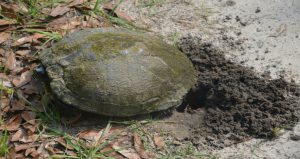Spring has sprung in Wakulla County, and the fact is reflected in the activity of the local flora and fauna. As expected, plants are sprouting leaves and blooming, and insect activity is accelerating.
Curiously, other cryptic manifestations indicate the return of warmer weather. Holes, sometimes the size of small craters, inexplicably appear in the lawn and landscape.
Sudden Voids in the Landscape
These sudden voids can develop under the cover of darkness and others open during the day when distractions moves attention away from the site in question. The unknown excavator is never seen or heard, only leaving the opening as a sign of their presence.
Explanations for the digging range from the absurd to the realistic. Much like crop circles of a few years ago, intergalactic travelers are not likely taking soil samples from the area for some nefarious purpose.
Midnight Burrowers
The most frequent midnight burrower is an armadillo, sometimes called a Florida-speed-bump or a Possum-on-the-half-shell. Armadillos eat adult insects and larvae commonly found in turf and under the soil.
As such they incessantly dig holes in lawns and landscapes in their search for food, many times uprooting plants in their quest. Their holes are approximately one to three inches deep and three to five inches wide.
Using insecticides to decrease the armadillo food supply is not guaranteed, but may help reduce the digging. In cases where there is a large, and always ravenous, armadillo population this reduction of food may increase digging activity as they search more diligently for a smaller food supply.
Voles are Omnivorous
Another possibility is a vole, a small rodent which is sometimes identified as a field mouse. These animals are not to be confused with moles, which are more likely to leave easily identifiable subterranean trails which erupt in long strands.
Voles are omnivorous. They will dine on insects and dead animals as well as plant material. This may include bark, leaves, stems, fruit, nuts or whatever else is easily available.
The small holes they leave are sometimes the opening to their burrow, in effect the front door to their home. They also tunnel under plants to consume their tender roots.
With their excellent burrowing and tunneling techniques, which give them easy access to sensitive areas without a clear or early warning, plants will suddenly die for no apparent reason. Only keen observation and detective work will identify the tiny culprit.
Gopher Tortoise
If a large hole, six to 12 inches in diameter, accompanied by a large mound of sandy soil appears, this is characteristic of a gopher tortoise. Their burrow entrances are always wider than they are tall to accommodate the dimensions of the tortoise’s shell.
Occasionally homeowners will find other burrows in the landscape. Many times the gopher tortoise gets the blame, but is not guilty of the transgression.
Florida Box Turtle
Rarely the holes and disrupted soil is a sign of good motherhood. This is the time of year when the female Florida box turtle (Terrapene carolina bauri ) is laying her eggs in a presumptively safe and secure site.

She digs a shallow hole, deposits the eggs and then covers it before departing. Ideally, the sun will warm the soil and incubate the next generation of this terpene species.
Unfortunately, there are times when the momma turtle is interrupted before she can lay the eggs. She will leave without covering the hole and seek a safer nesting site.
Usually unobserved by humans, the hole is frequently attributed to other creatures like squirrels.
In addition to the season of renewal, the spring is the season of renewed digging. Walk with caution.
To learn more about Wakulla County’s holes in the landscape, contact the UF/IFAS Wakulla County Extension Office at 850-926-3931 or http://wakulla.ifas.ufl.edu/.
| The Institute of Food and Agricultural Sciences (IFAS) is an Equal Opportunity Institution authorized to provide research, educational information, and other services only to individuals and institutions that function with non-discrimination with respect to race, creed, color, religion, age, disability, sex, sexual orientation, marital status, national origin, political opinions, or affiliations. U.S. Department of Agriculture, Cooperative Extension Service, University of Florida, IFAS, Florida A&M University Cooperative Extension Program, and Boards of County Commissioners Cooperating |
 0
0
